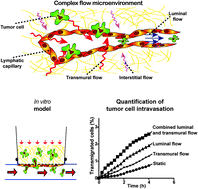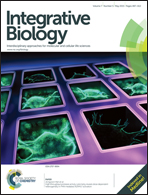An in vitro model of the tumor–lymphatic microenvironment with simultaneous transendothelial and luminal flows reveals mechanisms of flow enhanced invasion†
Abstract
The most common cancers, including breast and skin, disseminate initially through the lymphatic system, yet the mechanisms by which tumor cells home towards, enter and interact with the lymphatic endothelium remain poorly understood. Transmural and luminal flows are important biophysical cues of the lymphatic microenvironment that can affect adhesion molecules, growth factors and chemokine expression as well as matrix remodeling, among others. Although microfluidic models are suitable for in vitro reconstruction of highly complex biological systems, the difficult assembly and operation of these systems often only allows a limited throughput. Here we present and characterize a novel flow chamber which recapitulates the lymphatic capillary microenvironment by coupling a standard Boyden chamber setup with a micro-channel and a controlled fluidic environment. The inclusion of luminal and transmural flow renders the model more biologically relevant, combining standard 3D culture techniques with advanced control of mechanical forces that are naturally present within the lymphatic microenvironment. The system can be monitored in real-time, allowing continuous quantification of different parameters of interest, such as cell intravasation and detachment from the endothelium, under varied biomechanical conditions. Moreover, the easy setup permits a medium-high throughput, thereby enabling downstream quantitative analyses. Using this model, we examined the kinetics of tumor cell (MDA-MB-231) invasion and transmigration dynamics across lymphatic endothelium under varying flow conditions. We found that luminal flow indirectly upregulates tumor cell transmigration rate via its effect on lymphatic endothelial cells. Moreover, we showed that the addition of transmural flow further increases intravasation, suggesting that distinct flow-mediated mechanisms regulate tumor cell invasion.


 Please wait while we load your content...
Please wait while we load your content...